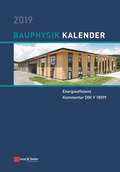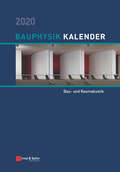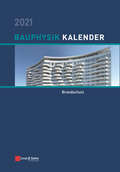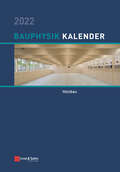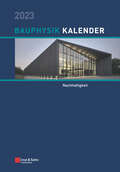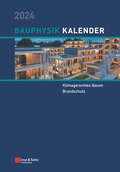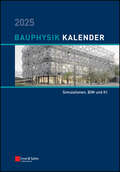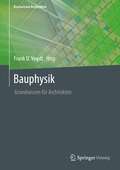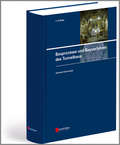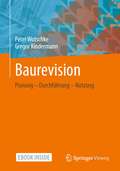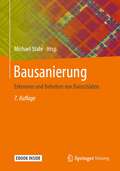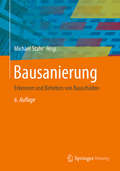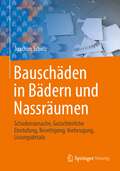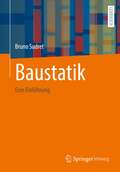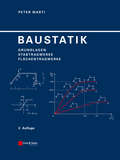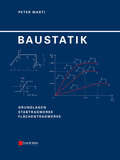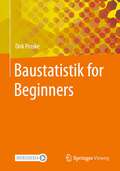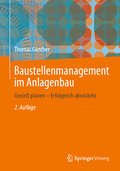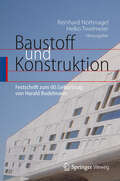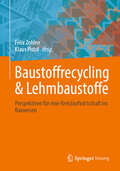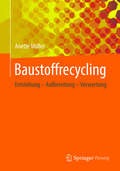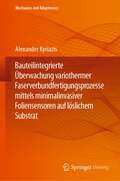- Table View
- List View
Bauphysik Kalender 2017: Schwerpunkt: Gebäudehülle und Fassaden (Bauphysik Kalender)
by Nabil A. FouadZukunftsfähige Gebäudehüllen werden der Interaktion von Außenwandkonstruktionen mit der Gebäudetechnik gerecht. Dabei müssen in einem integralen Planungsprozess die verschiedenen Anforderungen berücksichtigt werden, wie z. B. Behaglichkeit der Gebäudenutzer, energetische Effizienzaspekte, ökonomische Effizienzaspekte und wartungsarme Lebensdauer, Schutz der Konstruktion gegen klimatische Einwirkungen. Die Entwicklung hin zu Niedrigstenergiegebäuden (nZEB - nearly zero-energy buildings) wirkt sich insbesondere auf den Entwurf der Gebäudehüllen aus. Ab 2021 sollen gemäß EU-Richtlinie über die Gesamtenergieeffzienz von Gebäuden (EPBD) alle Neubauten als Niedrigstenergiegebäude gebaut werden. Gebäude, die von Behörden als Eigentümer gebaut werden, sollen bereits ab Anfang 2019 diesen Standard einhalten. Um diesen zu erreichen, müssen die Gebäude vor allem gut gedämmt sein und erneuerbare Energiequellen nutzen. Messtechnische Untersuchungsmethoden und rechnerische Nachweisformate hinsichtlich Wärme- und Feuchte- und Schallschutz werden vorgestellt und erläutert. Eine besondere, neue Rolle kommt der Tageslichtnutzung zu. Das Kompendium der Dämmstoffe im Bauwesen sowie der aktualisierte Beitrag über die Berechnung von Wärmebrücken sind Planungsgrundlagen für die tägliche Praxis. Auf aktuellem Stand sind auch in diesem Jahrgang die Materialtechnischen und Brandschutztechnischen Tabellen. Der neue Bauphysik-Kalender 2017 mit dem Schwerpunktthema Gebäudehülle und Fassaden bietet eine solide Arbeitsgrundlage und ein verlässliches aktuelles Nachschlagewerk für die Planung in Neubau und Bestand. Der Bauphysik-Kalender ist ein Kompendium für die richtige Umsetzung bauphysikalischer Schutzfunktionen mit Normenüberblick und -kommentierung, Materialdaten, Berechnung und Nachweisführung sowie praxisgerechten konstruktiven Lösungen auf den Gebieten Wärme- und Feuchteschutz, Schallschutz sowie Brandschutz.
Bauphysik Kalender 2018: Schwerpunkt: Feuchteschutz und Bauwerksabdichtung (Bauphysik Kalender)
by Nabil A. FouadDer neue Bauphysik-Kalender 2018 mit den Schwerpunkten Feuchteschutz und Bauwerksabdichtung bietet eine solide Arbeitsgrundlage und ein topaktuelles und verlässliches Nachschlagewerk für die Planung dauerhafter Bauwerksabdichtungen. Feuchte in Baukonstruktionen ist eine der häufigsten Schadensursachen an Gebäuden und Bauwerken. Nicht selten stehen mangelhafte oder fehlerhafte Bauwerksabdichtungen am Beginn der Schädigung. Die Vielzahl von Baukonstruktionen und Materialkombinationen erfordern fundiertes Wissen über den Wärme- und Feuchtedurchgang, über die Funktionsweisen von Abdichtungen und die geeigneten baulichen Maßnahmen, um fehlerhafte Planung als Schadensursache auszuschließen. Dabei geht es um den Schutz der Baukonstruktion selbst, um die Aufrechterhaltung der Standsicherheit und der Gebrauchstauglichkeit, wie z. B. Wärmeschutz oder WU-Betonkonstruktionen, und um die Abwehr von Gefahren. Viele Bauwerksabdichtungen können nicht nachgebessert werden, so dass sie für die gesamte Lebensdauer funktionsfähig sein müssen. Seit Juli 2017 liegen nun alle Teile der neuen Normenreihe DIN 18531 bis 18535 für die Abdichtung von Dächern und Balkonen, von befahrbaren Verkehrsflächen aus Beton, von erdberührten Bauteilen, von Innenräumen, von Behältern und Becken vor. Hinzu kommt DIN 18195 mit der alten, wohlbekannten Nummer, in welcher Begriffe sowie Abkürzungen und Bezeichnungen definiert sind. Der Bauphysik-Kalender 2018 gibt einen Überblick über die neue Normenstruktur und wichtige Änderungen. Außerdem umfasst das Buch praxisgerechte Hinweise und Hintergrunderläuterungen aus erster Hand zu allen Normenteilen. Insbesondere den Dächern, den erdberührten Bauteilen und den WU-Konstruktionen sind mehrere Kapitel gewidmet. Für die richtige Beurteilung von Feuchtelasten und Wasserbeanspruchungen werden wertvolle Hinweise gegeben. Im Bestand können Feuchte- und Salzschäden auftreten. Dann ist für eine wirtschaftliche und dauerhafte Sanierung die richtige Analyse eine unabdingbare Voraussetzung. Auch Monitoring, z. B. bei Flachdächern, kann größere, sanierungsbedürftige Schäden vermeiden. Verschiedene Methoden werden in diesem Buch vorgestellt und anhand von Beispielen erläutert. Auf aktuellem Stand sind auch in diesem Jahrgang die Materialtechnischen und die Brandschutztechnischen Tabellen. Der Bauphysik-Kalender ist ein Kompendium für die richtige Umsetzung bauphysikalischer Schutzfunktionen mit Normenüberblick und -kommentierung, Materialdaten, Berechnung und Nachweisführung sowie praxisgerechten konstruktiven Lösungen auf den Gebieten Wärme- und Feuchteschutz, Schallschutz sowie Brandschutz.
Bauphysik Kalender 2019: Schwerpunkt (Bauphysik Kalender)
by Nabil A. FouadDas Instrumentarium für Entwurf und Bemessung energetischer Konzepte unter Einbeziehung der licht- und wärmedurchlässigen Gebäudehülle sowie der Heizungs- und Klimatechnik, der Beleuchtung und der stromerzeugenden Anlagen liefert DIN V 18599 "Energetische Bewertung von Gebäuden - Berechnung des Nutz-, End- und Primärenergiebedarfs für Heizung, Kühlung, Lüftung, Trinkwarmwasser und Beleuchtung" Teile 1 bis 12 in der aktuellen Fassung von 2016. Diese Norm ist das Recheninstrument, mit dem alle Bilanzanteile umfassend und mit vertretbarem Aufwand zusammengeführt werden können und die Effizienz eines Gebäudes ganzheitlich bewertet werden kann. Im Bauphysik-Kalender 2019 werden alle zwölf Normteile aktuell aus erster Hand für die Praxis kommentiert. Dabei werden die Hintergründe und Grundlagen von Nutzungsrandbedingungen erläutert und Hinweise für die Erstellung eigener Nutzungsprofile gegeben. Es wird gezeigt, wie sich unterschiedliche Ausführungen des Wärmeschutzes, des Sonnenschutzes und der Bauart auf den Heizwärmebedarf und Kühlbedarf auswirken. Die Bewertung von Anlagenkonzepten und die Nachweise nach dem Erneuerbare-Energien-Wärmegesetz EEWärmeG werden dargestellt. Auf den Einfluss der Betriebsführung der Anlagentechnik und der Gebäudeautomation wird eingegangen. Außerdem werden Hinweise zur Praxistauglichkeit und -relevanz einiger Kennwerte gegeben. Die Verfahren zur Ermittlung der Primärenergiefaktoren werden ebenfalls erläutert. Das neue Tabellenverfahren nach DIN V 18599 Teil 12 stellt vorausgewertete Tabellen für die Aufwandszahlen von Anlagenteilbereichen der Anlagentechnik zur Verfügung. Damit wird die energetische Bewertung von Gebäuden und der Anlagentechnik transparenter und übersichtlicher. Zukünftig wird dies auch für ausgewählte Typen von Nichtwohngebäuden möglich sein. Berechnungsbeispiele und Beispielgebäude in den einzelnen Kommentaren dienen der direkten Praxisanwendung der Norm. An die Planer werden also hohe Anforderungen gestellt, daher zeigen Beiträge mit Ausführungsbeispielen z. B. zukunftsfähigen Geschosswohnungsbau, energieeffiziente Hotelbauten, Systemoptimierung eines solarbasierten Wärmepumpen-Heizsystems, Fensterkonstruktionen mit Vakuumglas und Untersuchungen zu Temperaturwechselbeanspruchungen an modernen Fassadenkonstruktionen. Das Kompendium der Wärmedämmstoffe sowie die Materialtechnischen Tabellen sind außerdem auf aktuellem Stand.
Bauphysik-Kalender 2020: Schwerpunkt: Bau- und Raumakustik (Bauphysik Kalender)
by Nabil A. FouadLärmschutz, Schallschutz und Raumakustik sind wichtige Qualitätskriterien bei der Bewertung von Gebäuden bzw. Räumen in allen Kategorien. Daher geben in dieser Ausgabe des Bauphysik-Kalenders die anerkannten Fachleute aus Normungsgremien und Ingenieurpraxis Hintergrundinformationen und Erläuterungen zu DIN 4109, zu VDI 4100, zu DIN 18041 sowie zum DEGA-Schallschutzausweis. Nach 29 Jahren fand 2018 eine Novellierung von DIN 4109 statt. Die strukturellen Veränderungen und die einzelnen Teile von DIN 4109 werden vorgestellt und teilweise mit der Norm aus dem Jahre 1989 verglichen. Das überarbeitete Berechnungsverfahren und insbesondere die erstmalig normativ geregelten erhöhten Anforderungen an den Schallschutz im neuen Entwurf E DIN 4109-5:2019-05 werden aus erster Hand kommentiert und erläutert. Um die akustischen Möglichkeiten und den damit verbundenen baukonstruktiven Aufwand bereits im Vorfeld eines Projektes einschätzen zu können, werden - getrennt für Massiv- und Leichtbau - typische Wand-, Decken- und Dachkonstruktionen, die in DIN 4109 geregelt sind, hinsichtlich ihrer schallschutztechnischen Leistungsfähigkeit untersucht und die Ergebnisse strukturiert aufbereitet und dargestellt. Dies ermöglicht den Vergleich unterschiedlicher Baukonstruktionen und die Auswahl entsprechend den Randbedingungen. Ein weiteres maßgebliches Regelwerk wurde mit Überarbeitung der Norm DIN 18041 "Hörsamkeit in Räumen - Anforderungen, Empfehlungen und Hinweise für die Planung" von 2016 neu gefasst. Mehrere Beiträge befassen sich mit Schall lenkenden und absorbierenden Maßnahmen und geben Beispiele für die Dimensionierung und die räumliche Verteilung schallabsorbierender und reflektierender Flächen in Räumen. Neben den Erläuterungen zu technischen Regelwerken wird eine Vielzahl von Themen aus der Praxis, wie z. B. Schallschutz im Holzbau, bei zweischaligen Haustrennwänden von Doppel- und Reihenhäusern, Trittschalldämmung, Schalldämmung bei Fenstern, Türen und Vorhangfassaden und Schallmessung am Bau, behandelt und anhand von Beispielen erläutert. Auf aktuellem Stand sind wiederum die Materialtechnischen und Brandschutztabellen. Der Bauphysik-Kalender 2020 ist ein einzigartiges und aktuelles Kompendium für die Raumakustik, die Bauakustik und den Schallschutz.
Bauphysik-Kalender 2021: Schwerpunkt: Brandschutz (Bauphysik Kalender)
by Nabil A. FouadDie Standardkapitel zur Brandschutzbemessung von Bauteilen für alle Bauarten nach den Eurocodes 1 bis 6 und gemäß Industriebau-Richtlinie wurden für die vorliegende Ausgabe aktualisiert und überarbeitet. Die ganzheitliche Betrachtung des vorbeugenden Brandschutzes unter Berücksichtigung der nutzungsbedingten Gefährdungspotentiale und Schutzziele spielt bei der Planung und Errichtung von Bauwerken eine wesentliche Rolle und verlangt von allen Beteiligten bei Entwurf und Planung, von Bauproduktenherstellern, Materialprüfungsämtern und Bauaufsichtsbehörden ein hohes Maß an Fachkenntnis über den aktuellen Stand der Technik aller relevanten Bereiche. Nur durch eine interdisziplinäre Zusammenarbeit können sichere und optimierte Brandschutzkonzepte entwickelt und realisiert werden, Umplanungen vermieden und Genehmigungsverfahren optimiert werden. Daher bietet die aktuelle Ausgabe des Bauphysik-Kalender spezielle Kapitel zur Anwendung der Ingenieurmethoden (z. B. Parkgaragen, Schulgebäude), zum spezifischen Brandverhalten ausgewählter Baumaterialien (z. B. Dämmstoffe aus nachwachsenden Rohstoffen) und zum spezifischen Brandschutz bei ausgewählten Baukonstruktionen (z. B. Außenwandbekleidungen). Im Hinblick auf die Wirtschaftlichkeit von Planungsentwürfen sind häufig Brandschutzkonzepte mithilfe von Ingenieurmethoden zielführend, während es in der Planung selbst durch Building Information Modelling (BIM) Einsparpotentiale gibt. Die Stellung des Brandschutzes im Bauordnungsrecht sowie die Regelungen zur Verwendung von Bauprodukten und Bauarten sind grundlegend und werden praxisnah erläutert. Wie immer bewegen sich alle Kapitel nahe an der Ingenieurpraxis und enthalten zahlreiche Beispiele. Auch verbreitete Fehler bei der Bauausführung und während der Nutzung werden diskutiert. Der neue Bauphysik-Kalender 2021 mit dem Schwerpunktthema Brandschutz bietet eine solide Arbeitsgrundlage und ein verlässliches aktuelles Nachschlagewerk für die Planung in Neubau und Bestand, und zwar sowohl für den konstruktiven Brandschutz als auch für die ingenieurmäßigen Brandschutzkonzepte.
Bauphysik-Kalender 2022: Schwerpunkt: Holzbau (Bauphysik-Kalender)
by Nabil A. FouadDie aktuelle Ausgabe des Bauphysik-Kalenders behandelt das gesamte bauphysikalische Themenspektrum rund um den Holzbau, welcher seit einigen Jahren eine wachsende Aufmerksamkeit erhält. Die Bauweise zeichnet sich durch geringes Gewicht und kurze Bauzeiten aufgrund der Vorfertigung aus. Energetisch optimierte Holzkonstruktionen mit großen Dämmstoffdicken sind im Holzrahmenbau und Holztafelbau möglich. Im Fokus dieses gewachsenen Interesses steht außerdem die Anwendung des nachwachsenden Rohstoffes Holz, weil das gebundene CO2 aus der Wachstumsphase im Gebäude gespeichert bleibt und ein relativ geringer Einsatz von Energie bei der Herstellung nötig ist. Damit dieser Vorteil gegenüber den Massivbauweisen mit Beton bzw. Mauerwerk tatsächlich zum Tragen kommt, muss die Lebensdauer der Gebäude und Bauwerke in Holzbauweise vergleichbar lang sein. Für die höheren Gebäudeklassen kommt hierbei den bauphysikalischen Aspekten eine entscheidende Rolle zu: Feuchteschutz, Wärmeschutz, Brandschutz müssen die Dauerhaftigkeit der Konstruktion sichern und, zusammen mit dem Schallschutz, die hochwertige Nutzung gewährleisten. Der Einsatz von Naturfaserdämmstoffen zu diesen Zwecken wird gemeinsam mit dem Holzbau ebenfalls attraktiver. Der neue Bauphysik-Kalender 2022 bietet eine solide Arbeitsgrundlage und ein verlässliches aktuelles Nachschlagewerk für die Planung in Neubau und Bestand, alle Kapitel bewegen sich nahe an der Ingenieurpraxis. Das Buch enthält Planungshinweise, Konzepte und Praxisbeispiele für energieeffizientes, schadenfreies, nachhaltiges Bauen mit Holz.
Bauphysik-Kalender 2023: Schwerpunkt: Nachhaltigkeit (Bauphysik-Kalender)
by Nabil A. FouadDie aktuelle Ausgabe des Bauphysik-Kalenders behandelt das gesamte Themenspektrum rund um Nachhaltigkeit bei der Errichtung von Gebäuden. Die Bauindustrie ist der Sektor, der in der Wirtschaft für die höchsten Umweltbelastungen verantwortlich ist. Integrierte Maßnahmen für mehr Klimaschutz und Ressourceneffizienz im Bausektor sind daher ein zentrales Thema der Umwelt- und Nachhaltigkeitspolitik. Die Regulierung zur Energieeinsparung hat bereits dazu geführt, dass der Primärenergiebedarf in der Nutzungsphase von Gebäuden immer weiter reduziert wurde. Es ist nun unabdingbar, die Bewertung von Gebäuden auf die Umweltwirkung und die Auswirkung auf das Klima auszuweiten. In diesem Buch werden die Lebenszyklusanalyse, die Nachhaltigkeitszertifizierung sowie die kreislaufgerechte Verwendung von Bauelementen, Baustoffen und Anlagenteilen umfassend erläutert. Konkretes Hintergrundwissen für klimagerechtes Bauen, für die Ermittlung der Ressourceneffizienz, das Recycling von Dämmstoffen, die Ökobilanzierung und die Zertifizierung werden anhand von Praxisbeispielen aufgezeigt, um Planenden das nötige Rüstzeug für die aktuellen Aufgaben an die Hand zu geben. Auch die Betrachtung von Klima-Fußabdruck und Ressourcen-Fußabdruck mithilfe eines digitalen Gebäudemodells bereits in der Planungsphase ist enthalten. Der Bauphysik-Kalender 2023 bietet eine solide Arbeitsgrundlage und ein verlässliches aktuelles Nachschlagewerk für die Planung in Neubau und Bestand, alle Kapitel bewegen sich nahe an der Ingenieurpraxis. Das Buch enthält Planungshinweise, Konzepte und Praxisbeispiele für nachhaltiges Bauen.
Bauphysik-Kalender 2024: Schwerpunkte: Klimagerechtes Bauen; Brandschutz (Bauphysik-Kalender-eBundle (Ernst & Sohn))
by Nabil A. FouadDer Bauphysik-Kalender 2024 gibt Praxishinweise für die klimagerechte Planung von Gebäuden, aber auch von urbanen Räumen. Diese sind durch die hohen Verdichtungen und Versiegelungen besonders anfällig gegenüber der Klimaveränderung mit häufigeren Extremwetterereignissen. Aber sie sind gestaltbare Orte, an denen durch eine interdisziplinäre und zukunftsorientierte Planung eine weitere Verschärfung des Klimawandels gebremst und die Resilienz von Mensch, Flora und Fauna gegenüber seinen Folgen gestärkt werden kann. Das Buch bietet aktuelles Wissen um bauphysikalische Prozesse zu verstehen, Potenziale von Konstruktionen gezielt auszuschöpfen und die Gebäudetechnik und Automatisierung funktional zu halten. Außerdem werden Tools und Nachweisverfahren getestet und kommentiert, mit deren Hilfe Bilanzen über die Umweltwirkungen von Gebäuden bzw. Bewertungen der Klimaanpassung von Gebäuden ermittelt werden können. Der zweite diesjährige Schwerpunkt Brandschutz widmet sich der Holzbauweise sowie der Untersuchung von Brandeinwirkungen durch E-Fahrzeuge und kraftstoffbetriebene Fahrzeuge in Parkgaragen. Der Bauphysik-Kalender 2024 bietet eine solide Arbeitsgrundlage und ein verlässliches aktuelles Nachschlagewerk für die Planung in Neubau und Bestand, alle Kapitel bewegen sich nahe an der Ingenieurpraxis. Das Buch enthält Planungshinweise, Konzepte und Praxisbeispiele.
Bauphysik-Kalender 2025: Simulationen, BIM und KI (Bauphysik-Kalender)
by Herausgegeben Ulrike KuhlmannThis book deals with hygrothermal building component simulation, fire, sound, daylight and building simulation as well as with urban climate and the flow of people simulation. Applications are used to show how AI can support decision-making in design and planning in the future.
Bauphysik: Grundwissen für Architekten (Basiswissen Architektur)
by Jan Bredemeyer Jasmin Fischer Anja Hofmann-Böllinghaus Juliane Nisse Falk Schaudienst Michael Schober Manuela Walsdorf-MaulDie Bauphysik zählt nicht nur zu den klassischen Disziplinen des Bauwesens. In den letzten Jahrzehnten hat die Bedeutung der Bauphysik durch gestiegene Ansprüche an die Behaglichheit und Nutzerzufriedenheit in den Gebäuden sogar erheblich zugenommen. Die Forderungen nach Energieeinsparung und Klimaschutz haben zudem zu einer stärkeren Einbeziehung bauphysikalischer Überlegungen in die Gebäudeplanung geführt. Das Buch behandelt die klassischen Teil- und Themenbereiche der Bauphysik: Wärmeschutz, Feuchteschutz, Schallschutz und Brandschutz. Dabei konzentriert sich die Darstellung auf das notwendige technische Grundwissen für Architekten. Ein Fokus wird auf die neue Energieeinsparverordnung mit dem Nachweisverfahren für Nichtwohngebäude nach DIN V 18599 gerichtet.
Bauprozesse und Bauverfahren des Tunnelbaus
by Gerhard GirmscheidThe successful completion of a tunnelling project depends on the choice of a construction method and the operational development. In this book, tunnelling methods and all the operational working steps are explained, starting from the geological situation.
Baurevision: Planung – Durchführung – Nutzung
by Peter Wotschke Gregor KindermannAufgabe der Baurevision ist, Bauprojekte auf Ordnungs- und Rechtmäßigkeit sowie Wirtschaftlichkeit hin zu überprüfen. Dieses Fachbuch stellt, am Enstehungsprozess eines Bauvorhabens - von der Idee bis um Betrieb - orientiert dar, wie die Projektabwicklung geplant und dokumentiert werden muss, damit sie einer Revision stand halten. Das Buch gibt eine Übersicht über nationale und internationale Regelungen und leitet aus Praxisbeispielen konkrete Handlungsempfehlungen ab.
Bausanierung: Erkennen und Beheben von Bauschäden
by Jürgen Weber Michael Stahr Klaus-Peter Radermacher Uwe Wild Virginie Schulz Hardy Dinse Friedhelm HensenGebäudesanierung und Bauen im Bestand sind auch zukünftig wichtige Themen, mit denen sich jeder Planer auseinandersetzen wird. Das Buch bietet Bauingenieuren und Architekten nicht nur einen systematisierten Einstieg in alle Bereiche der Sanierung, sondern auch weiterführendes Praxiswissen für die Durchführung von Sanierungsmaßnahmen. Alle Kapitel wurden wieder aktualisiert, konkretisiert und weiter illustriert. Neu hinzugekommen ist ein Kapitel mit rechtlichen Aspekten zur Sanierung.
Bausanierung: Erkennen und Beheben von Bauschäden (Vieweg Praxiswissen Ser.)
by Michael StahrGeb#65533;udesanierung und Bauen im Bestand sind auch zuk#65533;nftig wichtige Themen, mit denen sich jeder Planer auseinandersetzen wird. Das Buch bietet Bauingenieuren und Architekten nicht nur einen systematisierten Einstieg in alle Bereiche der Sanierung, sondern auch weiterf#65533;hrendes Praxiswissen f#65533;r die Durchf#65533;hrung von Sanierungsma#65533;nahmen. Alle Kapitel wurden wieder aktualisiert , konkretisiert und weiter illustriert. Neu hinzugekommen ist ein Kapitel mit rechtlichen Aspekten zur Sanierung.
Bauschäden in Bädern und Nassräumen: Schadensursache, Gutachterliche Einstufung, Beseitigung, Vorbeugung, Lösungsdetails
by Joachim SchulzDieses Fachbuch stellt anhand von Beispielen und Prinzipskizzen Planungs- und Ausführungsfehler in Bädern und Nassräumen vor und analysiert diese. Den Schwerpunkt der Betrachtungen bildet der Bereich der Feuchteschäden in Badezimmern, Duschräumen und Schwimmbädern.
Baustatik: Eine Einführung
by Bruno SudretDieses Lehrbuch bietet eine Einführung in die Strukturmechanik, die sich an Studenten des Bauingenieurwesens und des Maschinenbaus richtet. Er behandelt sowohl statisch bestimmte als auch unbestimmte Strukturen (Balken, Fachwerke, Bögen und Seile) und beinhaltet eine umfassende Darstellung der Kontinuumsmechanik und Elastizitätstheorie, auf der die Balkentheorien von Euler-Bernoulli und Timoshenko rigoros aufgebaut werden können. Ein Schwerpunkt liegt auch auf der Anwendung von Energiesätzen für strukturelle Systeme. Im Unterschied zu den meisten verfügbaren Lehrbüchern, die die Analyse von Strukturen als einen Katalog von Methoden darstellen, die speziell auf die eine oder andere Art von Struktur anwendbar sind, legt dieses Buch den Schwerpunkt auf Methoden der Strukturanalyse, mit einer klaren Verbindung zur Kontinuumsmechanik.
Baustatik: Grundlagen, Stabtragwerke, Flächentragwerke (Institut Für Baustatik Und Konstruktion Ser. #203)
by Peter MartiDas Werk liefert eine einheitliche Darstellung der Baustatik auf der Grundlage der Technischen Mechanik. Es behandelt Stab- und Flächentragwerke nach der Elastizitäts- und Plastizitätstheorie. Es betont den geschichtlichen Hintergrund und den Bezug zur praktischen Ingenieurtätigkeit und dokumentiert erstmals in umfassender Weise die spezielle Schule, die sich in den letzten 50 Jahren an der ETH in Zürich herausgebildet hat. Als Lehrbuch enthält das Werk viele durchgearbeitete Beispiele und Aufgaben zum vertieften Studium. Die einzelnen Kapitel werden durch Zusammenfassungen abgeschlossen, welche die wichtigsten Lehrinhalte in prägnanter Form hervorheben. Die verwendeten Fachausdrücke sind in einem Anhang definiert. Als Nachschlagewerk enthält das Buch ein umfassendes Stichwortverzeichnis. Die Gliederung des Inhalts und Hervorhebungen im Text erleichtern die Übersicht. Bezeichnungen, Werkstoff- und Querschnittswerte sowie Abrisse der Matrizenalgebra, der Tensorrechnung und der Variationsrechnung sind in Anhängen zusammengefasst. Insgesamt richtet sich das Buch als Grundlagenwerk an Studierende und Lehrende ebenso wie an Bauingenieure in der Praxis. Es bezweckt, seine Leser zu einer sinnvollen Modellierung und Behandlung von Tragwerken zu befähigen und sie bei den unter ihrer Verantwortung vorgenommenen Projektierungs-und Überprüfungsarbeiten von Tragwerken zu unterstützen. Die 1. Auflage war erfreulicherweise nach kurzer Zeit vergriffen, so dass diese 2., korrigierte Auflage vorgelegt werden kann.
Baustatik: Grundlagen, Stabtragwerke, Flächentragwerke (Institut Für Baustatik Und Konstruktion Ser. #203)
by Peter MartiDas Werk liefert eine einheitliche Darstellung der Baustatik auf der Grundlage der Technischen Mechanik. Es behandelt Stab- und Flächentragwerke nach der Elastizitäts- und Plastizitätstheorie. Es betont den geschichtlichen Hintergrund und den Bezug zur praktischen Ingenieurtätigkeit und dokumentiert erstmals in umfassender Weise die spezielle Schule, die sich in den letzten 50 Jahren an der ETH in Zürich herausgebildet hat. Als Lehrbuch enthält das Werk viele durchgearbeitete Beispiele und Aufgaben zum vertieften Studium. Die einzelnen Kapitel werden durch Zusammenfassungen abgeschlossen, welche die wichtigsten Lehrinhalte in prägnanter Form hervorheben. Die verwendeten Fachausdrücke sind in einem Anhang definiert. Als Nachschlagewerk enthält das Buch ein umfassendes Stichwortverzeichnis. Die Gliederung des Inhalts und Hervorhebungen im Text erleichtern die Übersicht. Bezeichnungen, Werkstoff- und Querschnittswerte sowie Abrisse der Matrizenalgebra, der Tensorrechnung und der Variationsrechnung sind in Anhängen zusammengefasst. Insgesamt richtet sich das Buch als Grundlagenwerk an Studierende und Lehrende ebenso wie an Bauingenieure in der Praxis. Es bezweckt, seine Leser zu einer sinnvollen Modellierung und Behandlung von Tragwerken zu befähigen und sie bei den unter ihrer Verantwortung vorgenommenen Projektierungs- und Überprüfungsarbeiten von Tragwerken zu unterstützen.
Baustatistik for Beginners
by Dirk ProskeDas vorliegende Buch dient dazu, Studierenden des Bauingenieurwesens Grundkenntnisse und nützliche Verfahren der Statistik auf einfache Art und Weise nahe zu bringen. Themen sind z.B. die Ermittlung der zentralen Schätzer wie Mittelwert, Median und Modalwert, die Ermittlung verschiedener Streuungsmaße, die Visualisierung von Stichproben mittels Häufigkeitsverteilungen und die Diskussion des Überganges zu den Wahrscheinlichkeitsverteilungen. Natürlich werden auch die höheren Momente, wie die Schiefe und die Kurtosis behandelt. Auch werden Sondereffekte wie Ausreißer oder zensierte Daten erläutert. Die Diskussion statistischer Verteilungen und die Festlegung dieser basierend auf Tests bilden ein weiteres wichtiges Thema. Außerdem behandelt das Buch statistische Tests zum Vergleich von Stichprobengruppen, wie den t- und den F-Test. Das Buch schließt ab mit den Grundlagen der statistischen Modellbildung. Zwar existiert im Augenblick vielfältige Software für die Durchführung statistischer Berechnungen, aber das Buch fokussiert stark auf der Anwendung der Tabellenkalkulationssoftware Excel, da diese Software weit verbreitet ist. Die Anwendung der statistischen Verfahren wird an einer Vielzahl von Beispielen gezeigt, die sich häufig auf baupraktische Fragestellungen beziehen.
Baustellenmanagement im Anlagenbau: Gezielt planen – Erfolgreich abwickeln
by Thomas GüntherDieses Buch beschreibt umfassend und praxisorientiert die gesamte Prozesskette, von der ersten montagetechnischen Machbarkeitsuntersuchung bis zur Errichtung der Anlage aus Sicht der Bau und Montage. Der Autor vermittelt auf leicht verständlicher Art und Weise die Prinzipien der Angebotsbearbeitung und des Nachunternehmermanagements, die Grundlagen der Bau- und Montagegewerke, das Zusammenspiel der Baustellenplanung und deren Steuerung bis zur Fertigstellung der verfahrenstechnischen Anlagen. Die auf Kennzahlen fokussierte Montageplanung, sowie die vereinfachte Darstellung der Zusammenhänge zwischen Planung und Steuerung machen das Werk zu einem wertvollen Begleiter für Berufseinsteiger und Profis. Erfahrene Projektleiter und Baustellenleiter werden besonders die interkulturelle Herangehensweise an das Thema schätzen.
Baustellenmanagement im Anlagenbau: Von der Planung bis zur Fertigstellung
by Thomas GüntherDieses Buch beschreibt den kompletten Prozess zur Errichtung einer Anlage im internationalen Umfeld. Der Autor vermittelt auf leicht verst#65533;ndlich Art und Weise die Grundlagen f#65533;r Bau und Montage, das Zusammenspiel der Planung und Steuerung bis zur Fertigstellung einer verfahrenstechnischer Anlagen. Die detaillierte Montageplanung sowie die vereinfachte Darstellung der Zusammenh#65533;nge der Planung und Steuerung machen das Werk zu einem wertvollen Begleiter f#65533;r Berufseinsteiger und Fachbauleiter. Baustellenleiter werden besonders die interkulturelle Herangehensweise an das Thema sch#65533;tzen.
Baustoff und Konstruktion: Festschrift zum 60. Geburtstag von Harald Budelmann
by Heiko Twelmeier Reinhard NothnagelExperten aus dem In- und Ausland erläutern in ihren Artikeln die Entwicklung und den Einsatz der Betontechnologie - insbesondere moderner Hochleistungsbetone. Ferner würdigen sie den Beitrag von Professor Harald Budelmann zur Baustoff- und Bauwerksprüfung. Breit diskutiert werden Fragen zur Dauerhaftigkeit und zur Nachhaltigkeit in der Baustoffentwicklung, andere, praxisbezogene Beiträge widmen sich der Zustandserfassung und der Instandsetzung oder auch der Beurteilung der Sicherheit und Leistungsfähigkeit von Bauwerken.
Baustoffrecycling & Lehmbaustoffe: Perspektiven für eine Kreislaufwirtschaft im Bauwesen
by Felix Zohlen Klaus PistolDas Buch konzentriert sich inhaltlich auf das Rückgewinnungspotential von Lehmbaustoffen. Die Herausforderungen und Chancen in der konkreten Anwendung werden durch Blickwinkel verschiedener Disziplinen wie besipielsweise Abfallwirtschaft und klassisches mineralisches Recycling präzisiert. In Ergänzung dazu werden die aktuellsten Daten aus dem Forschungsprojekt Muster UPD Lehm 2.0 der FH Potsdam, TH OWL, Bauhaus Uni Weimar und dem Dachverband Lehm veröffentlicht. Das Buch ist ein Tagungsband.Präzise Textbeiträge, neue Daten, Diagramme und eigene Abbildungen mit ausführlichen Bildunterschriften. Rückgewinnungspotentiale von Lehmbaustoffen aus unterschiedlichen Perspektiven verschiedener Fachdisziplinen wie Abfallwirtschaft, Baustoffrecycling und Architektur.
Baustoffrecycling: Entstehung - Aufbereitung - Verwertung
by Anette MüllerDie Notwendigkeit, Stoffkreisläufe im Bauwesen zu etablieren ist unbestritten. Das Wissen dazu ist an vielen Stellen vorhanden und wird im vorliegenden Buch zusammengefasst und systematisiert. Nach einem allgemeinen Überblick zu den Anfallmengen, Verwertungsquoten und Einsatzgebieten von Recycling-Baustoffen wird darauf eingegangen, auf welchen Aufbereitungsschritten das Recycling gegenwärtig basiert und welche Möglichkeiten der Einflussnahme auf die Produkteigenschaften bestehen. Des Weiteren werden Recycling-Baustoffe charakterisiert und deren Einsatzgebiete dargestellt. Ausgangspunkt ist immer der ursprüngliche Baustoff, der sich später im Bauabfall wiederfindet. Dabei liegt der Schwerpunkt auf den bautechnischen Eigenschaften. Die umwelttechnischen Aspekte, die seit Jahren die Diskussion bestimmen, sind im notwendigen Umfang aufgezeigt. Den Abschluss des Buches bildet ein Kapitel, das neue Entwicklungen in der Aufbereitungstechnik präsentiert und die Potenziale von Bauabfällen als Rohstoffquelle analysiert.
Bauteilintegrierte Überwachung variothermer Faserverbundfertigungsprozesse mittels minimalinvasiver Foliensensoren auf löslichem Substrat (Mechanics and Adaptronics)
by Alexander KyriazisUm bei der Fertigung von Faserverbundkunststoffen Zeit, Energie und Kosten sparen zu können, werden möglichst viele Informationen über die Vorgänge während des Fertigungsprozesses benötigt. Die Integration von Foliensensoren in die hergestellten Bauteile ist eine von mehreren Möglichkeiten, diese Informationen zu erhalten. Foliensensoren bestehen aus einer thermoplastischen Folie, auf der metallische Elektroden strukturiert sind. Ihre Integration in das Bauteil bringt unterschiedliche Vor- und Nachteile mit sich. Einerseits sind bauteilintegrierte Sensoren flexibler einsetzbar als werkzeugintegrierte Sensoren und ermöglichen eine feinere räumliche Auflösung der Aushärtevorgänge. Andererseits werden sie bei der Fertigung zum Produktbestandteil. Sie sollten deswegen einfach und kostengünstig sein, sowie die Lasttragfähigkeit nicht beeinträchtigen. Aus mechanischer Sicht bringen Foliensensoren vor allem ein Delaminationsrisiko mit sich. Die Wahl des thermoplastischen Substratmaterials macht dabei den entscheidenden Einflussfaktor aus. Während Sensoren auf Basis des häufig verwendeten Materials Polyimid ein erhebliches Delaminationsrisiko mit sich bringen, ist der Einfluss von Polyetherimid weit weniger schädlich oder verbessert sogar einzelne Festigkeitskennwerte. Neben dem Substratmaterial wirken sich auch die metallischen Sensorstrukturen auf die Belastbarkeit aus. Zur Gestaltung minimalinvasiver Sensoren sollte ein möglichst geringer Metallisierungsgrad angestrebt werden. Das verbreitetste Design für Foliensensoren zur Aushärteüberwachung sind sogenannte Interdigitalelektroden, die eine elektrische Kapazität bilden, deren Impedanz von der direkten Umgebung beeinflusst wird. In variothermen Fertigungsprozessen besteht eine Herausforderung darin, den Einfluss der Temperatur von dem des Aushärtegrades zu trennen. Die an integrierten Sensoren gemessenen Impedanzinformationen müssen dazu eine Verarbeitung durchlaufen, in deren Verlauf die Frequenzabhängigkeit und die Einflüsse von Temperatur und Sensorgeometrie aus den Daten entfernt werden. Für eine variotherme Aushärteüberwachung ist daher die Verwendung eines zusätzlichen Temperatursensors unverzichtbar. Die Sensordaten bieten darüber hinaus Potential für die Ermittlung des Faservolumengehalts oder zur Detektion von Harzfehlanmischungen.


